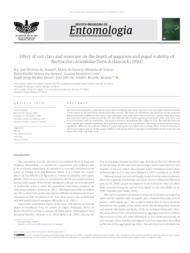Effect of soil class and moisture on the depth of pupation and pupal viability of Bactrocera carambolae Drew & Hancock (1994).
Effect of soil class and moisture on the depth of pupation and pupal viability of Bactrocera carambolae Drew & Hancock (1994).
Author(s): AMARAL, E. J. F. do; SOUSA, M. do S. M. de; SANTOS, J. E. V. dos; COSTA, L. M.; MELEM JUNIOR, N. J.; TOLEDO, J. J. de; ADAIME, R.
Summary: Bactrocera carambolae is a quarantine pest present in Brazil and today represents the main phytosanitary barrier to the export of the fresh fruits produced in the country. The effect of soil classes and moisture on the pupation depth and pupal viability of this insect was evaluated. Soils with three textural classes (sandy, sandy clay loam and clay loam) and four moisture levels (0%, 30%, 60% and 90% of field capacity of each soil) were used, for a total of 12 treatments with six repetitions. The pupation depths varied from the surface to 5 cm. The soil class was the most significant variable regarding the pupal development of B. carambolae. The moisture level did not have a significant effect on the pupation depth or pupal emergence, but there was a strong effect of the interaction of soil texture and moisture on the pupal viability, with an increase in emergence with higher moisture in the clay loam and sandy clay loam soils.
Publication year: 2021
Types of publication: Journal article
Unit: Embrapa Amapá
Keywords: Biologia Animal, Fruit flies, Textural classe
Observation
Some of Embrapa's publications are published as ePub files. To read them, use or download one of the following free software options to your computer or mobile device. Android: Google Play Books; IOS: iBooks; Windows and Linux: Calibre.
Access other publications
Access the Agricultural Research Database (BDPA) to consult Embrapa's full library collection and records.
Visit Embrapa Bookstore to purchase books and other publications sold by Embrapa.

